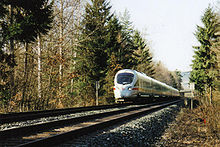Die Länderbahn GmbH (DLB), formerly Vogtlandbahn GmbH, is a German rail transport company based in Viechtach, operating transport services originally only in the Vogtland, but now also on a regional basis. Die Länderbahn is a subsidiary of Regentalbahn AG, which is owned by Ferrovie dello Stato subsidiary Netinera. The term vogtlandbahn remains in use as a trademark of Die Länderbahn in Vogtland.
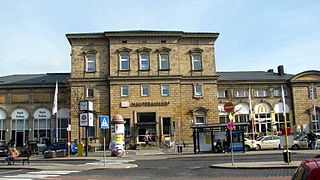
Bayreuth Hauptbahnhof is the main railway station in the German town of Bayreuth, in northern Bavaria.

The Royal Saxon State Railways were the state-owned railways operating in the Kingdom of Saxony from 1869 to 1918. From 1918 until their merger into the Deutsche Reichsbahn the title 'Royal' was dropped and they were just called the Saxon State Railways.
Mittelsachsen is a district (Kreis) in the Free State of Saxony, Germany.

Hof Hauptbahnhof is the main railway station in Hof in southern Germany and is situated at the intersection of the Saxon-Franconian trunk line (Magistrale) and the Munich–Regensburg–Leipzig–Berlin line. When it was opened it formed the boundary between the former Bavarian Ludwig South-North Railway Lindau–Hof to the Saxon-Bavarian Railway on the Saxon side from Hof–Leipzig.
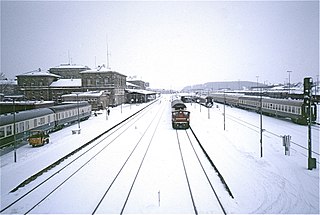
The Bamberg–Hof railway is a 127 kilometre-long main line that runs through Bavaria in southern Germany. The line runs from Bamberg via Lichtenfels, Kulmbach, Neuenmarkt-Wirsberg and Münchberg to Hof. The section from Hof to Neuenmarkt now forms part of the Saxon-Franconian trunk line.

The Interregio-Express (IRE) is a local public transport railway service operated by the Deutsche Bahn which is only available in the German states of Baden-Württemberg, Bavaria, Saxony, Saxony-Anhalt and Berlin as well as in Switzerland. The IRE service was first introduced in the 2001 summer timetable, due to the increasing abolition of Interregio routes by DB's long-distance division. As a result, several German states ordered InterRegioExpress trains on the routes affected. In addition IRE trains were also introduced on routes that had not previously had an Interregio service.
The Leipzig–Hof railway is a two-track main line in the German states of Saxony, Thuringia and Bavaria, originally built and operated by the Saxon-Bavarian Railway Company. It runs from Leipzig through Altenburg, the Werdau wye junction, Reichenbach and Plauen to Hof. The Werdau–Hof section is part of the Saxon-Franconian trunk line (Sachsen-Franken-Magistrale), the line connecting Dresden and Nuremberg. Its first section opened in 1842 and it is one of the oldest railways in Germany.

The Bayreuth–Neuenmarkt-Wirsberg line is a single-track main line railway in the German state of Bavaria. It is an important section of the so-called Saxon-Franconian trunk line from Dresden to Nuremberg. The line was opened in 1853 and is one of the oldest railways in Germany.
The Dresden–Werdau railway is an electrified, double-track main line in the German state of Saxony. It runs from Dresden via Freiberg, Chemnitz and Zwickau to Werdau wye, where it joins the Leipzig-Hof railway.

Reichenbach (Vogtland) Oberer Bahnhof(Upper station) is the main railway station of Reichenbach im Vogtland in the German state of Saxony. It is the only remaining station in Reichenbach, which once had three stations, and is located on the Saxon-Franconian trunk line between Nuremberg and Dresden. It is also the last major station before the junction with the main line to Leipzig from the direction of Nuremberg and Plauen. Together with Plauen station, it used to be one of two DB Fernverkehr stations in Vogtland.

The Nuremberg–Cheb railway is a 151 km long, non-electrified main line, mainly in the German state of Bavaria. It runs from Nuremberg via Lauf an der Pegnitz, Hersbruck, Pegnitz, Kirchenlaibach, Marktredwitz and Schirnding to Cheb in the Czech Republic. The route is also known as the RightPegnitz line or the Pegnitz Valley Railway (Pegnitztalbahn). It was built as the Fichtel Mountains Railway (Fichtelgebirgsbahn). The Nuremberg–Schnabelwaid section of it is part of the Saxon-Franconian trunk line (Sachsen-Franken-Magistrale).

The Schnabelwaid–Bayreuth railway is an 18.2 km long single-track main line from Schnabelwaid via Creußen to Bayreuth in the German state of Bavaria. It is part of the Saxon-Franconian trunk line.
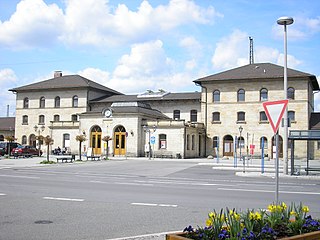
Lichtenfels station is in the town of Lichtenfels in Upper Franconia in the German state of Bavaria. It is a regional rail hub and a former ICE stop on the Hamburg–Berlin Munich route and is classified by Deutsche Bahn as a station of category 3.

Saalfeld station is the station in the city of Saalfeld in the southeast of the German state of Thuringia. It is classified by Deutsche Bahn as a category 3 station.

The Göltzsch Viaduct is a railway bridge in Germany. It is the largest brick-built bridge in the world, and for a time it was the tallest railway bridge in the world. It spans the valley of the Göltzsch River between the Reichenbach im Vogtland district of Mylau and the adjacent town of Netzschkau in the German Free State of Saxony.
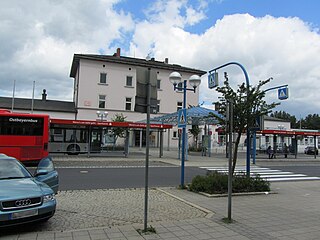
Marktredwitz station is the station of the major district town of Marktredwitz in the Bavarian administrative region of Upper Franconia. Two main lines, the Nuremberg–Cheb railway and the Weiden–Oberkotzau railway, cross at the station. It is classified by Deutsche Bahn as a category 3 station and has five platform tracks.

Freiberg (Sachs) station is a station on the Dresden–Werdau railway and the Nossen–Moldava railway in Freiberg in the German state of Saxony. Until 1995 it was also the start of the disused Freiberg–Halsbrücke railway.

Werdau wye junction is a wye junction near Werdau in west Saxony, Germany where the Dresden–Werdau railway meets the Leipzig–Hof railway.
The Augsburg–Nördlingen railway is an electrified main line in Bavaria, Germany, originally built and operated as part of the Ludwig South-North Railway (Ludwig-Süd-Nord-Bahn) from Lindau to Hof. It runs from Augsburg via Donauwörth to Nördlingen.


